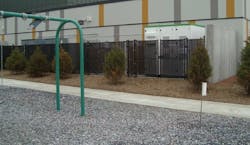Before jumping into the benefits and opportunities for energy storage systems (ESSs), we first need to level set. What is an ESS, and why do we use them?
An ESS collects energy when it is abundant — or at low cost — and releases it at a designated time. This could be during peak energy demand, during peak utility cost time frames to reduce overall utility charges, or deployed at any time to create less reliance on the utility grid. The most common type of ESS used in the construction industry is a battery storage system with lithium-ion batteries. Other types of storage systems consist of ice storage, pumped hydro, green hydrogen, and compressed air energy. These alternate storage systems aren’t as prevalent in traditional construction projects, so we will focus on the battery style for this discussion.
Energy storage devices are starting to be more widely used, especially when there is a priority for renewable energy sources and where the use of solar photovoltaic (PV) and other energy collecting systems have the potential to produce more energy than a facility can utilize in real time.
Energy storage options
There are several ways ESSs can be utilized. Battery energy storage systems (BESSs) can be operated in a grid-tied mode or as part of a microgrid to provide power during grid failure. The electrical design and associated components will change based on the assets utilized, code requirements, interconnection to the grid, and distribution methodology.
In a grid-tied operation, the storage system is programmed to charge and discharge at various times to help with load shedding and demand response. Typically, the system will discharge the storage system during times of high demand or when on-site production is low to help reduce the energy usage and cost of the facility. Even though this sounds like a simplistic concept, it is a complex technology and feat as demand, production, and storage are all monitored and controlled. The controller is constantly trying to optimize its decisions — charge, discharge, or do nothing — aiming to maximize economic benefits based on the available energy assets. This is one of the most challenging aspects of installing an ESS.
In contrast, the ESS could be incorporated into a microgrid. In a microgrid design, the storage system would act as a buffer for one or more on-site power generating devices (e.g., traditional generator, fuel cell, solar PV, wind turbine, CHP, etc.) and interact with the traditional utility source, helping the microgrid controller to balance power production and demand more effectively. The microgrid system is significantly more complex as the system constantly works to balance all resources and demands on the system; however, it can also provide a very high level of resiliency that could allow operation without utility power for long durations of time.
Design decisions
Careful consideration of the electrical distribution system should be taken when implementing an ESS to maximize the effectiveness of generation and storage. A connection on the main switchgear creates a cohesive system with the most flexibility. However, this may not be the optimal solution for an existing building. Existing electrical services require tailored solutions to meet the needs of a given building.
One limitation of the ESS that should be acknowledged is that the round-trip efficiency of storage and retrieval processes causes energy losses. Battery storage systems’ round-trip efficiency ranges between 85% and 95%, but losses to heat and parasitic loads are the current hurdles. This hurts the site’s energy usage. All the constraints of the ESS require ongoing technology advancements, optimization, and planning to ensure the demand can be accommodated by the equipment and the design.
And let’s not forget about the code requirements, opportunities, and constraints for the utilization of ESSs. Battery storage has been in NFPA 70 (National Electrical Code) for decades, but it wasn’t until 2016 when NFPA 855, Standard for the Installation of Stationary Energy Storage Systems, was initiated with the first edition issued by the Standards Council in 2019. (Fun fact: Lore says that the standard number “855” was created because it looked like “ESS”). This document focuses solely on ESSs and provides minimum requirements for mitigating the hazards associated with ESS.
This standard works in conjunction with other codes such as: the NEC; NFPA 99, Health Care Code; NFPA 110, Standard for Emergency and Standby Power Systems; and NFPA 111, Stored Electrical Energy Emergency and Standby Power Systems. Each iteration of these documents continues to refine and address how these storage systems have evolved and how adherence to energy constraints has modified acceptability and design opportunities. We would strongly suggest picking up a copy of each of these documents and reading through the “Origin and Development” chapter of each code or standard. It helps paint a picture of how far we have come from an energy distribution perspective and creates context on how to understand where an ESS is acceptable by code. And, as always, it is important to understand which codes and standards are adopted, modified, and enforced in each jurisdiction and how energy targets for states and jurisdictions interact with these requirements.
ESS appeal
So, with some of these constraints and limitations, what is the allure of utilizing an ESS? The potential to offset energy costs and boost resilience, especially with the increase in natural disasters, power outages, and other emergencies, is a solid start. Standalone systems are typically not practical yet (due to the large capacity and duration many facilities would need to operate solely on an ESS), but pairing an ESS with conventional energy sources reduces utility costs and limits fuel consumption.
But not everyone is jumping on the ESS bandwagon. Initial costs are still high, and return on investment (ROI) is often long without external incentives. Not only is the cost high but the technology to control the system is also still relatively new, scaring some away until the technology is further developed. The new Inflation Reduction Act (IRA) Section 48 Investment Tax Credit (EITC) now expands the projects and credit thresholds to include energy storage technology if the construction begins by Jan. 1, 2025. This enables non-taxable entities to get a tax refund.
HGA has helped clients apply for and win grants to help offset the initial cost of an ESS and has collaborated with schools and public safety buildings to develop and install BESSs. Moreover, we have conducted a comprehensive feasibility study for implementing a BESS in a hospital. HGA is tackling this complexity by analyzing and optimizing the controller and operational performance of the BESS at a net-zero school in Wisconsin, which is designed to offset 100% of its on-site energy needs.
As our society becomes more eco-conscious, renewables paired with ESSs are starting to take center stage to align with states and cities adopting energy usage targets. Energy storage is the future — and understanding the options, constraints, cost, ROI, and opportunities will help integrate them into more of our power distribution systems.




